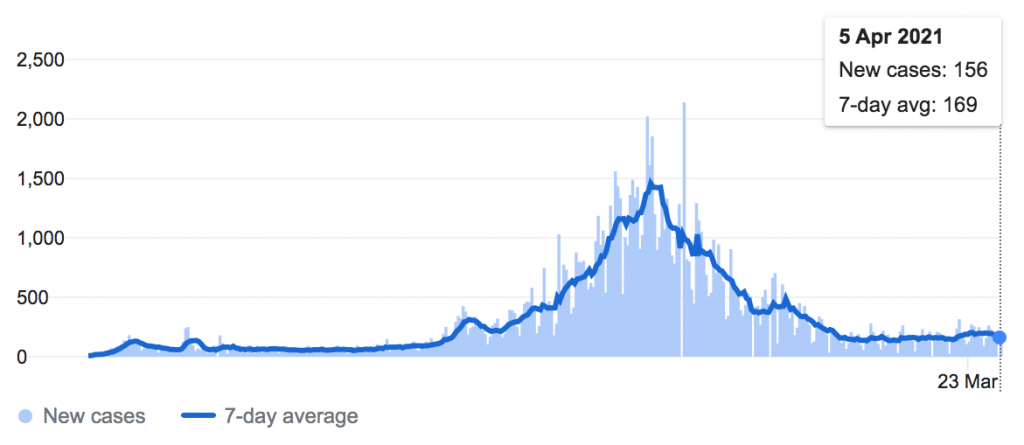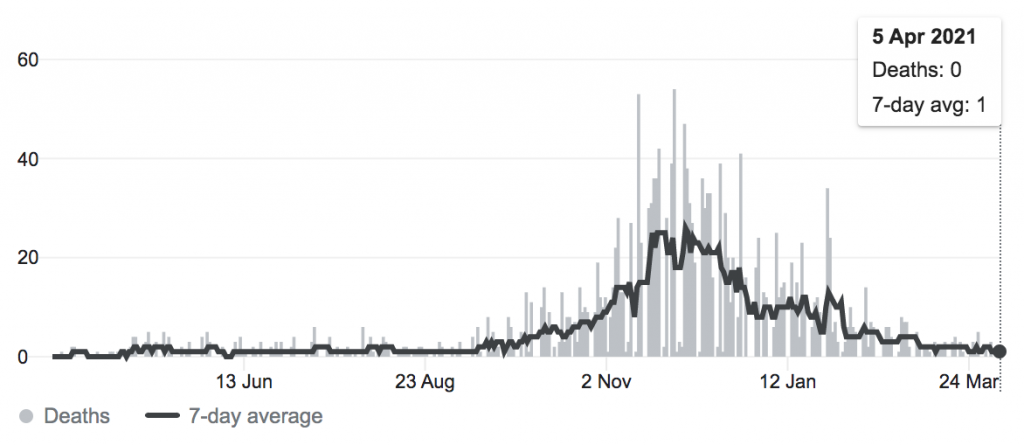As I noted back in March, South Dakota may have taken the least restrictive approach to COVID-19 of anywhere in the Western world.
Its conservative governor, Kristi Noem, has been a stalwart opponent of lockdowns: when the state’s epidemic burgeoned at the end of August, there were practically no restrictions in place. Despite this, case numbers fell rapidly after reaching a peak in mid November. And by late February, they were in the low triple digits.
How has it fared since then? Case numbers have remained low, averaging about 170 per day:

And deaths have continued to fall. The last seven days saw an average of just one death per day:

Although South Dakota has the eighth highest death rate among US states, its epidemic retreated without any government intervention. (And no new restrictions were introduced in March or the first week of April.)
What’s more, South Dakota has done better economically than most other states and Western countries. According to the Bureau of Economic Analysis, its GDP fell only 1.7% in 2020 – the seventh lowest among US states. (Britain’s GDP plunged nearly 10% last year.) In addition, South Dakota currently has the lowest unemployment rate out of all 50 states – at just 2.9%.
One might say, “You can’t equate GDP and unemployment with human life”, but that simply isn’t true. The money to pay for the NHS (and programs like Medicare and Medicaid in the US) comes from taxing economic activity: the less economic activity, the less money there is available. And that’s before you even factor in the social costs of unemployment and bankruptcy.
One should be cautious about extrapolating from South Dakota to countries like Britain, given the state’s low population density. However, the trajectory of its epidemic casts serious doubt on the models that led us into lockdown.













To join in with the discussion please make a donation to The Daily Sceptic.
Profanity and abuse will be removed and may lead to a permanent ban.
Please, please, please, stop saying “cases” when you mean “positive tests”.
Orwell knew the score on language dictating thought: this isn’t a new revelation.
BB is begging humans please, please stop saying what they have already written because he don’t like books. “cases” means humans who are tested at least one time positive for a virus i.e. HIV or Influenza while “positive test” used with anonymous testing where tests counted
What incoherent nonsense.
BB accused Noah Carl for saying “case” but he dont’t tell the number of “positive tests” in South Dakota for the reported “cases”.
Orwell reported from human that they will not be able to cite correctly, so they get incoherent nonsense instead the written information
Thank you you are spot on. why oh why has virtually everyone including ‘Sceptics’ slid into the ‘Cases’ trap? A case has always been associated with actual illness until March 2020. Drives me mad as well.
If the draconian measures (including masks) taken in more populous areas had any affect at all, then the high density factor should have been cancelled out. After all, that was the whole point of lockdowns and social distancing and all that stuff, right? Keeping people apart. Even perfectly healthy people.
Experts are also credited with creating an easy-to-understand message of avoiding what are called the “Three C’s” — closed spaces, crowded spaces and close-contact settings — rather than keeping away from others entirely.Although political leadership was criticized as lacking, that allowed doctors and medical experts to come to the fore — typically seen as a best practice in managing public health emergencies. “You could say that Japan has had an expert-led approach, unlike other countries,”
The town with worldwide highest density factor (much higher than Tokio or Paris) with high OAF has cases similar to Taiwan.
https://hub.jhu.edu/2020/09/22/coronavirus-transmission-model-averts-rohingya-humanitarian-crisis/
“The money to pay for the NHS (and programs like Medicare and Medicaid in the US) comes from taxing economic activity: the less economic activity, the less money there is available.”
That’s simply untrue. A complete myth.
If it is technically feasible, ie we have the manpower free and knowhow to do it, the UK government can pay for it.
That at least should be clear from the past year. The money for the NHS comes from Parliament in a Supply and Appropriation Act. It is paid by virtue of s15 of the Exchequer and Audit Department Act 1866. Nothing else is required.
200 page document explaining precisely how here: https://gimms.org.uk/2021/02/21/an-accounting-model-of-the-uk-exchequer/
The *less* economic activity there is the more physical capacity there is for the NHS. It’s when the private sector is booming that the NHS gets squeezed – as people move to work in the private sector.
We have provisioned the nation with a small fraction of people engaged for over a year. Why do these ‘shortage of money’ myths persist. It’s irrational.
Spending causes additional taxation and additional saving. The two match by accounting identity.
The spending always comes first.
Heavens, the lack of understanding demonstrated by that post. Almost unbelievably idiotic (and apologies, I know that is flattering the creature)!
And yet you have no response to it other than belief. Even though there is 200 pages of evidence backing it.
Quite astonishing groupthink.
The NHS is funded by the people who work in it, who use their money to demand output, which others then make for them, which keeps them employed, and so on. Cash registers don’t discriminate.
You can’t pay taxes until you have Sterling, and Sterling come from government. Very difficult to take a rabbit out of a hat, unless somebody put it in there first.
Unless you really believe in magic.
Let’s try this as an explanation……
10 men in a bar decide to settle their £100 weekly beer bill in roughly the same way as we pay our taxes:
– so the first four men, the poorest, paid nothing
– the fifth paid £1
– the sixth paid £3
– the seventh paid £7
– the eighth paid £12
– the ninth paid £18 and
– the tenth man, the richest, paid £59
Then the barman decided to give them a £20 discount for being such good customers. The group wanted to continue to pay the new £80 bill the same way as before. While the first four men still drank for free, the other six divided up the £20 windfall by following the progressive principle of our tax system:
– so the fifth man, like the first four, now paid nothing – a saving of 100%
– the sixth paid £2 instead of £3 – a saving of 33%
– the seventh paid £5 instead of £7 – a saving of 29%
– the eighth paid £9 instead of £12 – a saving of 25%
– the ninth paid £14 instead of £18 – a saving of 22% and
– the tenth paid £49 instead of £59 – a saving of 17%
The men then began to compare their savings. “I only got £1 out of the £20” declared the sixth man. He pointed to the tenth man, “but he got £10; the wealthy get all the breaks!” “wait a minute“ said the first four men, “we didn’t get anything at all. This new system exploits the poor.” So the other nine men surrounded the tenth man and beat him up. The next week he didn’t show up for drinks, so the nine sat down and had their beers without him. But when they came to pay, they discovered they didn’t have enough money between them to pay even half the bill.
QED
Is that like a Ponzi scheme?
Government has no money of its own. All the money comes from taxpayers – i.e. the private sector.
So the public sector workers pay no tax? Bet they must love that.
Total crap. The NHS is funded mainly from general taxation supplemented by National Insurance contributions.
The Government lays out its principal financial plans for the year in the budget. The budget lays out future spending and taxation plans. The Government generally uses the Supply and Appropriation Bill towards the end of the financial year to request any additional funding required.
I could elaborate but for you I just can’t be arsed.
The government doesn’t have any money, they collect taxes in many forms from we the people.
If this were true then Government spending wouldn’t exceed taxes raised every single year, and yet it quite clearly does
Have you heard that they borrow money, which is called the National Debt?
It’s called the Magic Money Tree
If you don’t understand that spending comes after taxation then no explanation is possible. If you do understand then no explanation is needed.
Utter incoherent drivel.
I would be interested to know what percentage of those tested die in SD to compare to the rest of the world. Put to bed those claims that although masks don’t stop you getting the virus, you’re more likely to get a mild case…
A while back someone posted a table & graph of all cause mortality in UK since 1850 ish.
It gave a true perspective on Covid vs the past.
Anyone recall where it may be found?
This one’s from 1950. It does understate the 2020 rate slightly but nothing dramatic.
https://www.macrotrends.net/countries/GBR/united-kingdom/death-rate
There’s a table from 1838 accessible here:
https://www.ons.gov.uk/peoplepopulationandcommunity/birthsdeathsandmarriages/deaths/adhocs/12735annualdeathsandmortalityrates1938to2020provisional
Raw death figures here (you need to google population figures per year to get more perspective, remember we’ve put on a good 12 million people in less than 20 years)
https://www.statista.com/statistics/281488/number-of-deaths-in-the-united-kingdom-uk/
Basically, we’re back to 2003 rates. The horror!
Thanks, there have been a few nutters over on CW posting yet again about unprecedented death rates in 2020 never seen before, bad as the Spanish flu etc etc.
As you say – horrors!
The most apt comparison to South Dakota is North Dakota.
ND had lockdowns and mask mandates, and its case and death rates and their distribution and trajectories were the same as SD’s.
That comparison is the best real world proof that neither lockdowns nor masks make any positive difference, only many and severe negative ones.
ND has since reopened and abolished the mask mandate too.
lockdowns tend to spread influenza, because more people stay in ‘sick rooms’ while mask can have an effect in ‘sick rooms’ (waiting rooms without proper ventilation) but the general use even in supermarkets, or other places with few talking, make any positive difference.
1918: similar to 3C
Keep the mouth and teeth clean
Don’t use common drinking cups,towels, etc.
Avoid fear & poorly ventilated places
Use mask ‘in sick rooms’
modern WWW:
Watch distance (even outdoor)
Wash hands (even outdoor)
Wear mask (outdoor) to control finger
found also 1918
What they did emphasize was Avoid Worry, Fear, and Fatigue. One thing that was subverted and neglected in this one.
Emphasizing is shown by the big illustration on the left side. They had not so strong beliefs likeTrump/Koch that chicken-pox and other herpes, measles and similar viruses had to use hands, so influenza was airborne for the group (similar ideology like 239 scientists nowadays regarding corona).
2017 showed a preventive medicine report (Elsevier-book instead modern facebook) the different likelihoods of developing seasonal influenza:
https://www.sciencedirect.com/science/article/pii/S2211335516301553
(‘stay at home’ could be translated in ‘No : Regularly go out’)
Correct.
Humans would need a ‘great reset’.
Switching back to Dr.Tedros first diagnosis
Isolating people and mask wearing are harmful to our health. This is a fact and one ignored by this useless government.
Did Cockhand give his evidence today re the opening of pubs later than other businesses? Can’t see the story anywhere so far.
Well done South Dakota –
Governor Noem, like Florida’s Governor DeSantis sought advice from world renowned scientific experts. Not sure about Governor Abbot of Texas, but ignoring the ongoing nonsense from Washington, seemed to work in favour of those states. A big thank you to Drs Scott Atlas, Sunetra Gupta, Martin Kuldorff, Jay Battacharya and so many, many others. They are the heroes of this story.
With all the testing all these countries are doing and with the fact that the virus is fully circulating in hospitals, anything up to 5 deaths per day per million is just going to be an endemic situation.